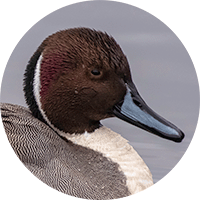Northern Pintail
Appearance: The Northern Pintail (56 cm - 22 inches) exhibits dimorphism, with distinct differences between sexes. The male pintail has a slender and elongated body, a brown head, and neck with a white stripe extending upwards. Its body is gray and marked with black and white patterns. The long central tail feather extends beyond the other feathers, giving it a distinct appearance. The female pintail is smaller and has mottled brown plumage, providing camouflage during nesting. It lacks the extended tail and has a more subdued appearance than the male. Both have a white trailing edge on dark speculum.
Habitat: The Northern Pintail is found in a range of wetland habitats during different parts of the year: Shallow coastal marshes, bays, inland lakes at up to 2600 m.
Behavior: The Northern Pintails are dabbling ducks, often feeding by tipping their heads underwater and grazing on aquatic vegetation, seeds, insects, and small invertebrates. They forage in shallow water or around the edges of wetlands.
Courtship and Breeding: Males display elaborate courtship behaviors to attract females, including head-bobbing, calling, and other visual displays. Once paired, they nest on the ground in dense vegetation or near water bodies.
Migratory Patterns: Northern Pintails undertake extensive migrations by traveling long distances to wintering grounds in northern South America.
Breeding: the Northern Pintail breeds in the high-altitude wetlands of the Andes mountains, including páramos, montane bogs, and lakes.
Wintering and Migration: During the non-breeding season, pintails migrate to coastal wetlands, including mangroves, estuaries, lagoons, and brackish marshes. They also utilize rice fields and flooded agricultural areas.
Conservation Status: The conservation status of the Northern Pintail is classified as "Least Concern" according to the International Union for Conservation of Nature (IUCN).
Distribution
Breeding Distribution:
During the breeding season, the Northern Pintail is known to inhabit the high-altitude wetland habitats of the Colombian Andes. These include páramos (high-altitude grasslands), montane bogs, and freshwater lakes found in the mountainous regions of the country. Breeding populations can be found in various departments of Colombia, such as Boyacá, Cundinamarca, Antioquia, and Huila, among others.
Wintering and Migration Distribution:
After the breeding season, Northern Pintails undertake extensive migrations to reach their wintering grounds, which are located primarily in northern South America. In Colombia, they can be found in different wetland habitats during the non-breeding season, including coastal areas and inland wetlands. The specific distribution of wintering Northern Pintails in Colombia can vary from year to year, as they move in response to food availability and environmental conditions.
Coastal regions along the Caribbean and Pacific coasts provide important wintering habitat for Northern Pintails in Colombia. This includes mangroves, estuaries, lagoons, brackish marshes, and other coastal wetland ecosystems. Certain regions and protected areas, such as the Ciénaga Grande de Santa Marta and the Chocó-Darién-Western Ecuador Mangroves, are known to support significant populations of Northern Pintails during the wintering period.
Migration corridors that follow river systems, such as the Magdalena and Cauca rivers, can also act as important stopover sites for pintails during their migration within Colombia.
Taxonomy
- Kingdom: Animalia
- Phylum: Chordata
- Class: Aves
- Order: Anseriformes
- Family: Anatidae
- Subfamily: Anatinae
- Genus: Anas
- Species: Anas acuta
Vocalization
Whistling Call: The most well-known vocalization of the Northern Pintail is a distinctive, high-pitched whistle or whistle-like call. This call is often described as a clear and melodious "wee-ooo" or "ke-WEE-oh" sound. It is typically heard during flight or when the birds are in groups.
Courtship Calls: During the breeding season, male Northern Pintails produce a range of whistling or ringing calls as part of their courtship displays. These calls include repeated notes, trills, and descending or ascending whistles. The purpose of these courtship calls is to attract females and establish territorial boundaries.
Grunting or Quacking Sounds: In addition to whistling calls, Northern Pintails can also produce soft grunting or quacking sounds, especially during social interactions or during feeding. These sounds are often used as a contact call among individuals in a group or flock.
Alarm Calls: When Northern Pintails feel threatened or perceive danger, they may emit short, shrill alarm calls to alert other birds to potential threats. These alarm calls are generally rapid and high-pitched, serving as a warning to other members of the flock.





